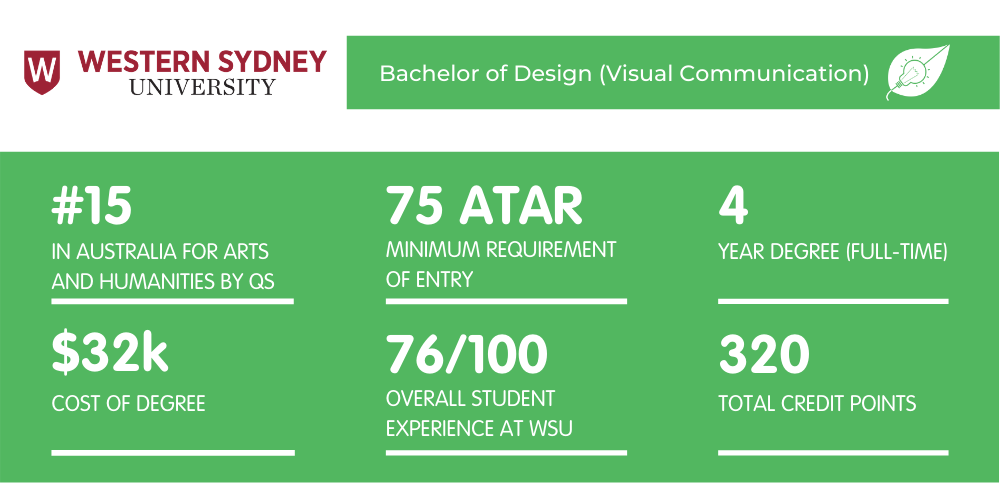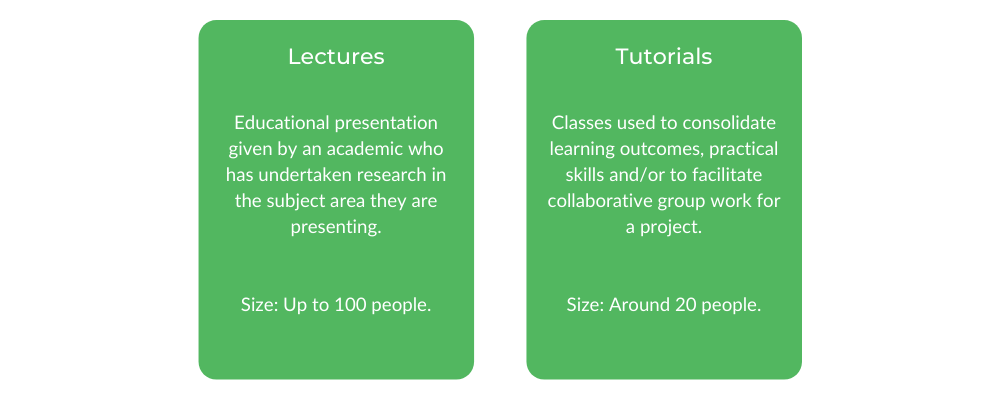Are you interested in design and communicating ideas visually? Then studying a Bachelor of Design (Visual Communication) at WSU could be the degree for you!
We’ll cover everything you need to know about studying this degree – from core units and majors to how to get in – in this handy guide.
Keep scrolling to find out more!
What is a Bachelor of Design (Visual Communication) at WSU?
Core Units and Majors
How to Get into Visual Communication at WSU
What’s the Teaching Format?
What’s the Faculty and Culture Like?
What is a Bachelor of Design (Visual Communication) at WSU?
A Bachelor of Design (Visual Communication) will equip you with practical skills and knowledge in design. While you will learn the fundamentals of design across different kinds of visual media, you can expect to also learn about the business side of the design world!
After three years, you can also choose to exit the program. This means that you will graduate with a Bachelor of Design Studies instead.
Dean’s Scholars Program
High-achieving students can also study a Bachelor of Design in Visual Communication as a Dean’s Scholar. This is an advanced version of the degree where students will have the opportunity to study additional subjects and complete a sub-major in Applied Leadership through The Academy!
Studying at The Academy will also allow students to attend special events and study in exclusive study spaces!
To be eligible for the Dean’s Scholars program, you will need an ATAR of 90 or higher, and you will need to maintain a grade-point average (GPA) or 5 or more during your studies.
Find out more about the benefits of studying at The Academy here!
Career Paths
Since so many aspects of life are visual, you can use your Bachelor of Design to pursue a variety of careers, including:
-
- Illustrator
- Art director
- Graphic designer
- Information designer
- Photographer
- Games designer
- Interactive designer
- Web designer
- Design educator
Once you graduate, you will also be eligible to become a member of the Design Institute of Australia (DIA) and the Australian Graphic Design Association (AGDA). Being a member of these associations will enable you to network with other designers and potential clients, as well as access to design-focused events!
Core Units and Majors
What are the Core Units?
Studying Visual Communication at WSU will give you a well-rounded education across different areas of design, so the core units are made up of a variety of design-related subjects.
In first year, you will learn about the fundamental principles and practices of graphic design, visual storytelling, and web design, as well as the historical movements and theories in design across six core units.
As you progress into second and third year, you can expect to complete more in-depth subjects in graphic design, as well as design research, social design, and Australian design units. You can also take the subjects from each of your chosen specialisations and electives!
In your final year, you will need to complete a major design project, professional experience units, and electives. You will work on the major design project across both semesters in consultation with an academic supervisor. The professional experience units will see you working in the Rabbit Hole studio as a junior designer.
Specialisations
While most degrees only let you choose one to major in, Bachelor of Design students are lucky enough to be able to choose two! For each specialisation that you choose, you will complete two units and have the option to complete additional practical units in these areas as electives.
The specialisations you can choose from are:
-
- Illustration
- Interactive Design
- Photomedia
- Digital Design
You can also choose to use your elective units to complete a sub-major. These require less units than a full major and are offered for a range of subject areas, such as Advertising Studies, Indigenous Australian Studies, and Business Sustainability.
Internships
Although internships are not a required part of the degree, there are opportunities to gain professional experience during your studies.
In fourth year, you will get to experience what it’s like to work as a designer by completing the professional experience units, and you can show your work at WSU’s annual design showcases. These showcases are attended by people from the design world and are a great way to expand your professional network!
How to Get into Visual Communication at WSU
The ATAR cut off for a Bachelor of Design (Visual Communication) is an ATAR of 75. If you don’t meet the ATAR requirements, there are several alternative pathways into your dream degree.
To find out which pathway could work for you, head here!
The College
A common pathway available for WSU students is The College. With a selection of Diplomas, Extended Diplomas, and University Foundation Studies available across faculties, you’re sure to find an option that suits you.
If you have an ATAR of 55 or higher, you can apply for the Diploma in Design/Bachelor of Design (Visual Communication), complete the 12-month diploma, and transition directly into your second year of the Bachelor’s degree. Or you can apply for the Diploma in Design Extended (Visual Communication) without an ATAR and study for an additional trimester before entering the Bachelor’s degree.
Are there any prerequisites or assumed knowledge?
There are no prerequisites or assumed knowledge that you will need to study Design at WSU, but having some artistic experience can be beneficial!
For instance, studying Visual Arts or taking some art classes can give you a head start when you begin to attend classes, especially if you choose to specialise in illustration.
Scholarships
WSU offers a range of scholarships for students experiencing hardship, from remote areas, or for anyone undertaking an undergraduate degree.
Head here for the full list of scholarships available!
What’s the Teaching Format?
To study a Bachelor of Design (Visual Communication) at WSU as a full-time student, you’ll be completing 3-4 subjects across two semesters a year.
Class Structure
If you choose to study Design at WSU, you can expect to develop your theoretical and practical knowledge across lectures and tutorials.
Lectures
Lectures form the bulk of your theory-based learning and generally run for 1-2 hours. These classes can vary in size, with up to 100 people attending at a time.
Some courses also offer guest lectures, where designers and other industry professionals come and explain different concepts or share their experiences!
Tutorials
These classes are smaller and more interactive than lectures, with around 20 people per class, and run for 2-3 hours.
Tutorials involve a lot of group work, as well as giving and receiving feedback. This also means that you will often need to work on material before class so that you can receive feedback and continue to work on it during class time.
How many hours do you have to go to university?
Studying Design at WSU generally means that you will be attending classes between 2-3 days — or 8-12 hours — a week.
While this is a pretty light load compared to degrees from other faculties, there is the expectation that you will work on assessments and prepare for class, so it’s important to manage your time!
What are the assessments like?
Design is a very practical field, so you will be assessed through assignments and online quizzes. This also means that you won’t have to worry about studying for exams (for your core units at least)!
Assignments
Assignments are worth the majority of your mark (about 40-50%) but are broken up into several smaller tasks that you will complete throughout the semester.
This often involves responding to a design brief, and tasks can include a research assignment, an analysis or reflection, and your final design or project.
Quizzes
You’re more likely to come across these assessments in your theory-based courses, and are worth about as much as an assignment task! These are held online and test your understanding of different theories and concepts.
Skills That You Refine and Learn
Not surprisingly, you’ll develop a host of skills in graphic design — think typography, branding, and image design — and your chosen specialisations. Along with those, you’ll become familiar with the tools and software that are used in the design industry, making the transition from university to working that much easier!
Responding to brief after brief will also help you develop your ability to put your theoretical knowledge into practice and hone your skills in research.
The focus on group work throughout the degree will also make you an expert in communicating with others and working in team environments. These skills are very versatile and can be handy to have for a variety of career paths and across industries!
What’s the Faculty and Culture Like?
Faculty and Culture
Since classes involve giving and receiving feedback, you’ll find that both lecturers and your classmates are supportive and happy to help out. The faculty is made up of practising designers and academics who are passionate and encouraging of their students.
While this can come with the pressure to perform well, rest assured that there are plenty of people you can turn to for help!
WSU also hosts exhibitions to display the work of third and fourth-year students.
For third-year students, they can display the projects they completed for specific units such as Social Design: Research and Practice, where they research and conceptualise campaigns to address social issues. Fourth-year Design and Visual Communication students can show off their final projects at WSU’s yearly Grad Show.
Societies
There are a variety of societies at WSU that cater to a range of professional and personal interests, so you’re sure to find one that interests you!
For Design students, you can submit photos, videos or articles to W’SUP, Western Sydney’s student newspaper. So if you want to give your artworks or compositions some exposure, send in your work to be published!
Check out the full list of societies here!
Rachel Fieldhouse is a Content Writer at Art of Smart Education and has just completed a double degree in Science and Arts at The University of Sydney, majoring in Chemistry, English, and Linguistics. Rachel’s writing has been published in Concrete Playground, Inside Enterprise, Planting Seeds, and SURG FM, and she currently writes blog posts for Remi AI, a Sydney-based Artificial Intelligence firm. When she’s not writing, you can find Rachel playing her saxophone or flute, or relaxing with some sudoku.






